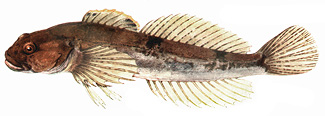Slimy Sculpin
Cottus cognatus
 Distribution: Slimy sculpin are found throughout most of the Northeastern United States and much of Canada. Southern limits include Virginia and western waterbodies through the Great Lakes. They are common in suitable habitat throughout New Hampshire in all but the coastal watersheds.
Distribution: Slimy sculpin are found throughout most of the Northeastern United States and much of Canada. Southern limits include Virginia and western waterbodies through the Great Lakes. They are common in suitable habitat throughout New Hampshire in all but the coastal watersheds.
Description: A broad, flat head is found on a body that ranges from brown to mottled black with a white underside. The dorsal fin is spotted with orange on breeding males. There are 7 to 10 spines in the first dorsal fin and 14 to 19 in the elongated second one. Most adult fish grow to two or three inches in length.
Species commonly confused with: Tesselated darter
Habitat: Sculpin prefer clear, cool streams or the rocky bottoms of cold lakes and ponds. When lying motionless in this type of substrate, they can be very difficult to see.
Life History: Slimy sculpin becomes sexually mature at two years and spawning occurs in the spring at 45° to 50°F. Males will select a nest site under the shelter of a rock or submerged log, branch or tree root. Females will suspend their adhesive eggs from this overhanging structure. Once fertilized, the male will defend the nest until after the eggs hatch in about 4 weeks.
Food sources include but are not limited to aquatic insects and invertebrates, crustaceans, small fish, and aquatic vegetation. Insect larvae are the primary food source in rivers and streams. Slimy sculpin often coexist with brook trout and they may offer an important food source. As a coldwater species, slimy sculpin are more common in the rocky and gravel bottomed rivers and streams of northern New Hampshire, where they can reach considerable numbers. They are a good indicator of water quality and cannot survive where acid levels are high.
Origin: Native
Conservation/Management: There are no specific conservation or management objectives for slimy sculpin. As with other cold water fish species, their range in New Hampshire may decrease over time due to climate change. One of the objectives of the Fish Conservation Program is to collect baseline fish community data for monitoring long term trends in the abundance and distribution of New Hampshire’s freshwater fish species, which will reflect changes in aquatic habitat and water quality across the state.



